Downtown Artists Paint To Change Skid Row
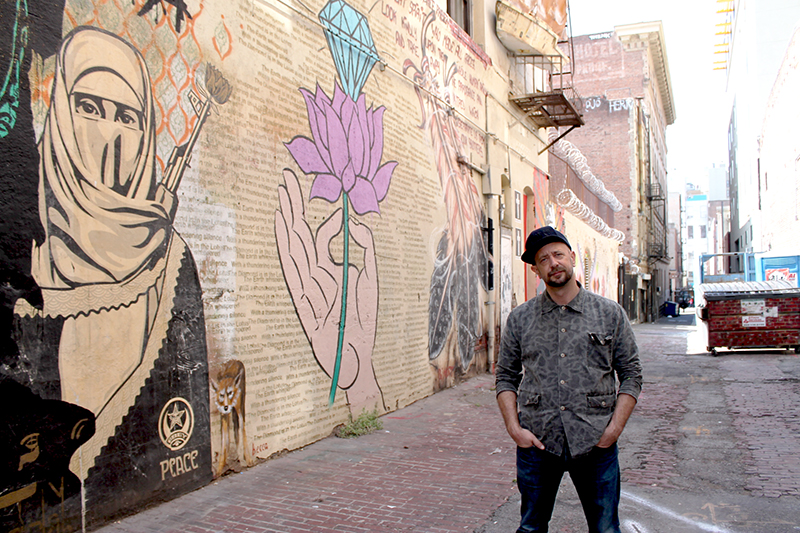
One group of visitors, a family of four, has come to the alley at just the right time. Before they can position their cameras between the gate’s bars, a door swings open, revealing a bearded man in a black baseball cap. “Hey, come on in,” he tells them. “The art’s meant to be seen.”
The man is Stephen Zeigler, a photographer who lives and works at 118 Winston, an art gallery and yoga studio located next to the alley. Zeigler makes a point of letting art admirers into the alley when he sees them, but he’s more than just a gatekeeper. The 44-year-old L.A. native is Winston Street’s unofficial curator, and something of a linchpin in the multifaceted effort to bring meaningful public art back to the area in and around Skid Row.
“All day long there are photographers, people with their cell phones,” he says. “Art has changed this whole place.”
Former mural capital of the world
Street art is certainly nothing new to Los Angeles, a city where large-scale public art has been a part of the landscape since as early as 1932, when pioneering Mexican muralist David Alfaro Siqueiros painted the 80-foot-long “América Tropical” on historic Olvera Street. Much of the city’s cultural history—the Chicano civic rights movement, the 1984 Olympics, key political leaders, artists and entertainers—was documented on its walls through the ’70s and ‘80s.
In the ‘90s, advertisers began commissioning murals for commercial purposes, leading to years of legal battle with the city. As a result, the L.A. City Council opted to impose an all-out ban on public murals in 2002, putting not only advertisers but also noncommercial muralists on the wrong side of the law. The ban was inconsistently enforced for more than a decade: While new works occasionally appeared around the city during that time—thanks in part to the controversial L.A. Freewalls Project—others were buffed out or unceremoniously painted over, to the frustration of local artists and art supporters.
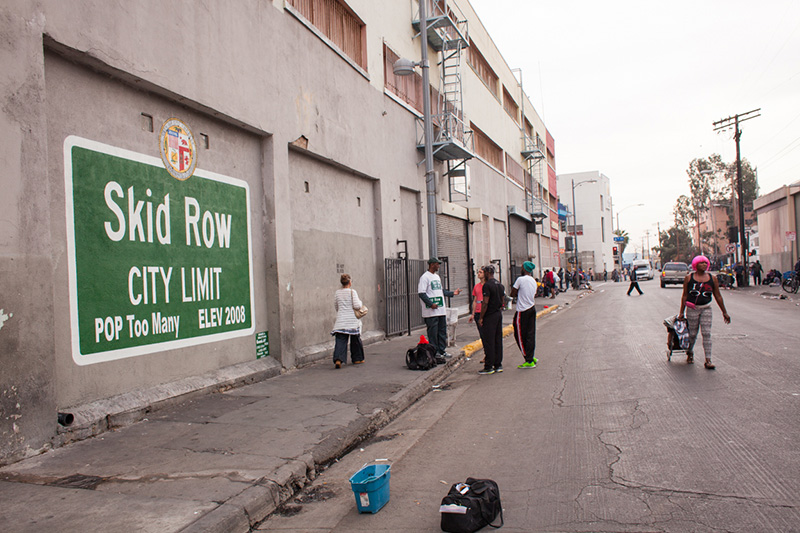
Indian Alley
Zeigler’s individual efforts began as a casual endeavor to clean up the area directly outside his home, which sits just inside the borders of Skid Row, one of L.A.’s poorest and most dangerous neighborhoods. When he and his wife Jodi moved into 118 Winston in 2008, the neighboring alley was still frequently used for drug dealing and prostitution.
“There used to be crack dealers in the alley every night,” he recalled during a recent interview. “Every morning there’d be syringes, piss and trash, and I’d clean it.”
In addition to cleaning, Zeigler began spraying poles, parking meters and fire hydrants on the block with gold paint—an attempt, he said, to cover up tagging and other blights no one else seemed to care about. He also started doing research on his neighborhood.
From books and old newspaper clippings, Zeigler began piecing together 118 Winston’s history: The building that was first a piano store in the 1880s was also a meeting place for the Catholic Knights of America, a mission, a labor hall, and from 1974 through the 1990s, the headquarters of the United American Indian Involvement, an organization providing addiction recovery services for Native Americans. Though officially called Werdin Place, the alley, Zeigler learned, was a popular hangout for homeless Native Americans known informally at the time as Indian Alley.
“This is a piece of history that a lot people don’t know about,” he said. It’s for that reason that he was ultimately inspired to put murals up on the alley’s walls.

Over the course of months, however, the alley amassed more than a full wall of work, with contributions from the likes of world-famous street artist Shepard Fairey (renowned for his 2008 Barack Obama “Hope” poster and OBEY clothing line), Native American artist Jaque Fragua and anonymous L.A.-based artist Wild Life (who in recent years has drawn attention for the ambitious papier-mâché scenes he’s installed around the city).
Many of the paintings directly reference the alley’s Native American history—large portraits of cultural figures like Robert Sundance and Toypurina grace the walls next to paintings of native icons like feathers and coyotes. Other works pay tribute indirectly: An abstract neon painting by German artist Mymo, for example, is meant to be a “sun portal” for troubled spirits to pass through.
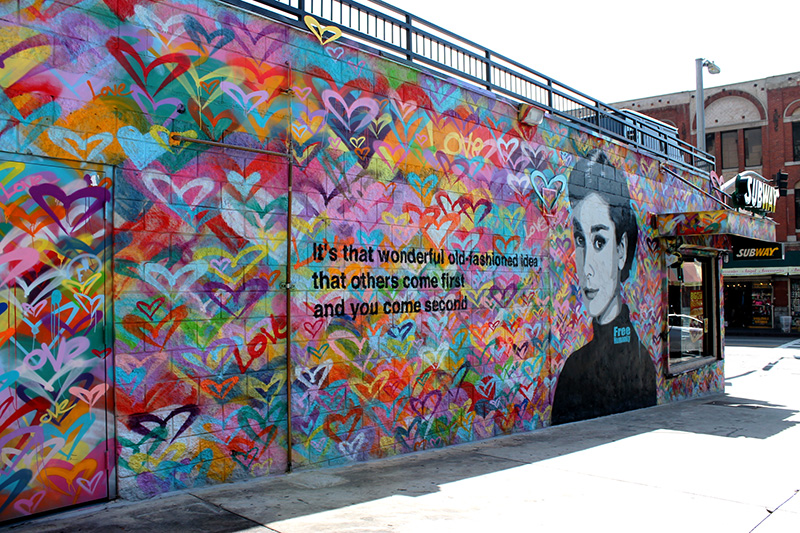
“People take care of things they’re proud of,” he said. “I think the residents and business owners of this area are proud of the murals and watch out for them.”
Micro-murals
Winston Street’s self-commissioned beautification project hit a figurative wall, however, when a painting done by Wild Life on a traffic utility box was buffed out several days later.
Zeigler reached out to Councilman Huizar’s planning director Tanner Blackman, who explained the reason for the buffing: Unlike commercial buildings, the utility boxes—which control traffic lights—are city property and cannot be painted on under the new mural ordinance without express permission from the L.A. Department of Transportation (LADOT).
Though Wild Life’s utility box painting had already been taken down, Blackman—an arts advocate who helped write the new mural ordinance—saw the conflict as an opportunity. The councilman’s office had already commissioned nine artists to paint micro-murals on utility boxes in Boyle Heights in November, and Blackman had been looking for someone to start up a similar project downtown.
“Our strategy has been to tap into the local arts community to find out who to reach out to,” Blackman said in a phone interview. “We were aware of what Stephen was doing in Indian Alley, and when this happened we thought, ‘Hey, why don’t you just curate all those boxes around Winston Street?’”
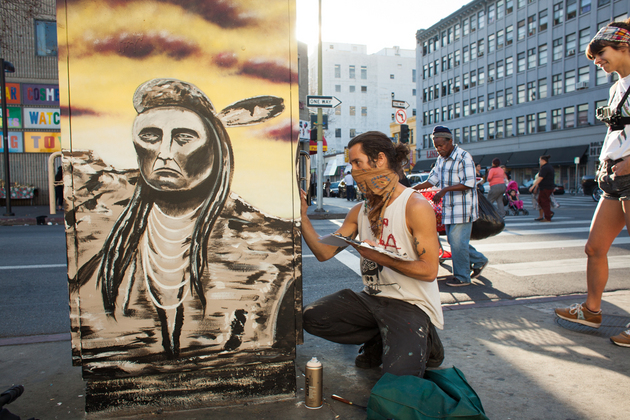
Each of the artists submitted a proposal, with Zeigler coordinating their paperwork. Approval for the six murals took several weeks, though Blackman says the process is relatively simple.
“LADOT will approve the project as long as the council office of the district where the box is located approves it,” he explained. “And as a courtesy, we make sure to tell LAPD so they know this artist isn’t a tagger.”
Not having to worry about the police was certainly a plus for the members of Winston Death Squad, several of whom are on probation after being arrested for illegally painting on public walls.
“It’s nice to just paint and not be looking over your shoulder,” said Teacher, whose real name is Keith Biele. “People came up and started talking to us and asking questions—the art brings a kind of light to the community.”
The first set of utility box micro-murals were completed on January 19, and Blackman says the process went so well that Huizar’s office gave Zeigler the go-ahead to curate more utility boxes throughout a portion of downtown’s Historic Core, spanning from Third to Ninth Streets between Spring and Los Angeles.
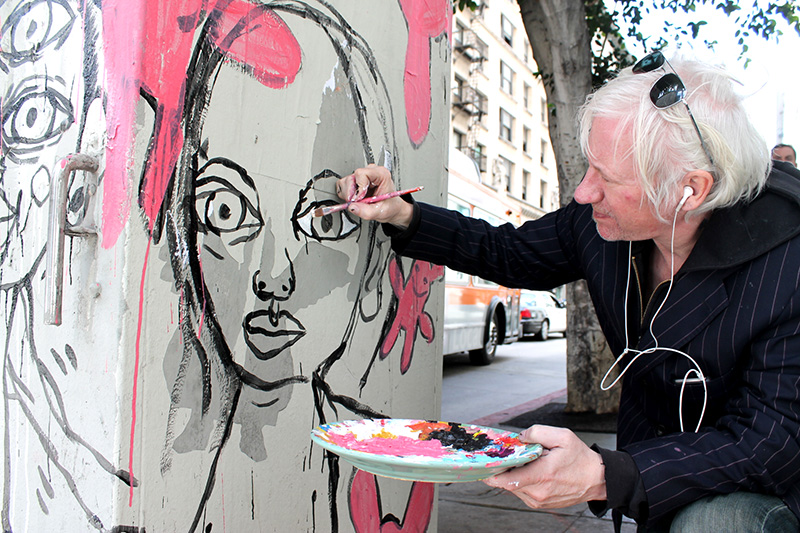
“This part of town is so eclectic,” he said. “I want these murals to reflect that.”
MORE PHOTOS: Curating L.A.'s Skid Row photo slideshow
SEE DOWNTOWN'S MICRO-MURALS: Downtown L.A. Utility Box Murals map
Reach Associate Editor Chrystal Li here.



